Gong is the most important idiophone in traditional music of Sabah indigenous people and found throughout Sabah state. Gong is usually made of brass or bronze, it produces muffled sounds of a deep tone, when its thick and broad rim was hit by a stick. As the backbone of most music ensembles, gong is played in almost every social event in Sabah.
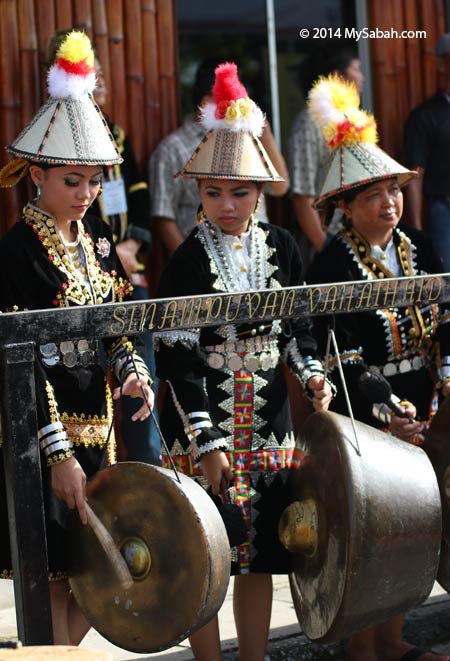
Pic: Kadazan Papar girls playing gong in Harvest Festival
When Sabahans want to dance, they beat the gong. When they want to celebrate wedding, they beat the gong. When someone dies, they also beat the gong. Gong is also played in other occasions such as animistic religion ceremonies, festivals and welcoming guests.
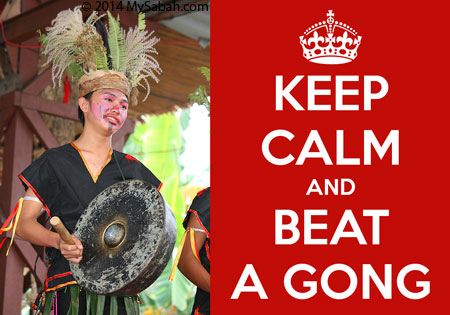
Gong is more than a musical instrument in old days without phones. Besides showing happiness and sadness, gong was also a communication tool to send signals to other villagers up to 5 miles away. The listeners can tell from the rhythm that if it’s a good or bad news. Slow rhythm means an invitation for having a drink. Fast rhythm indicates danger. When someone is dying the beats start slowly at first increase in speed and then on death resume a slow beat.
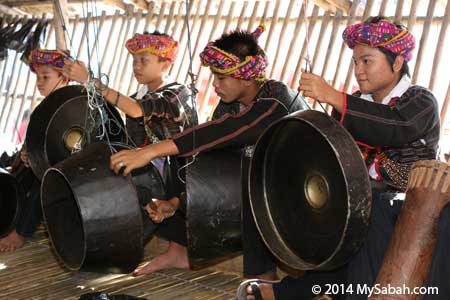
Pic: Rungus boys beating gong in longhouse
In the past, gong is highly valued and owning gong is a sign of wealth. Villagers would exchange livestock for a gong and gong is one of the common items in dowry. Gong is valued by its age and tone. People that time can recognise the unique sound from individual gong and even tell if a gong has flaw. Therefore, stealing of gong is rare, because owner (and other villagers) will locate his gong once the thief beats it.
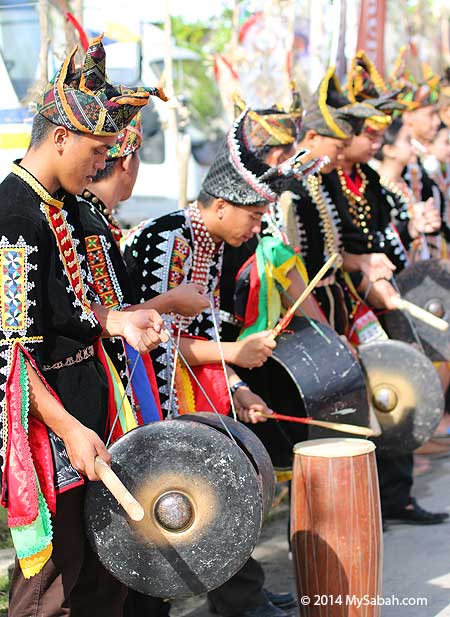
Pic: Dusun Tindal people from Kota Belud playing gong
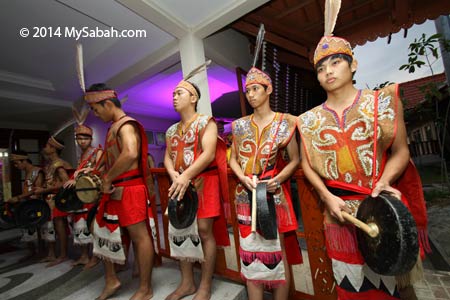
Pic: Murut playing gong to welcome guests
Gong is widely used by Kadazandusun, Murut and Bajau people in their traditional music. Each ethnic group has its own distinct musical forms such as the number of gong used, styles, tempos and tunings, and in combinations of other instruments such as drums to accentuate the main rhythms. A set of 5 to 12 gong is being played in most cases, sometimes it can go up to 36 gong.
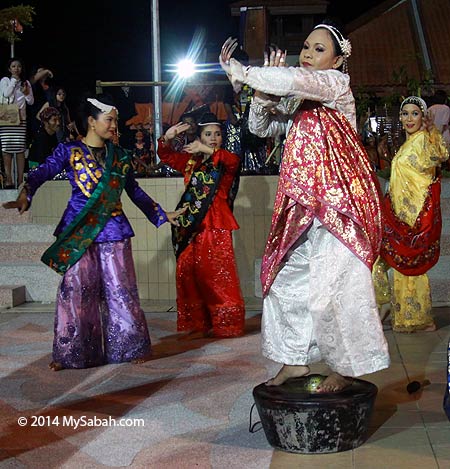
Pic: Sulu Sandakan dancing on the gong
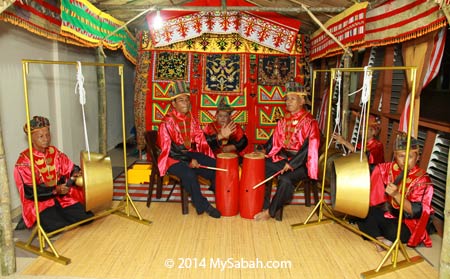
Pic: Use of gong in Betitik music of Bajau
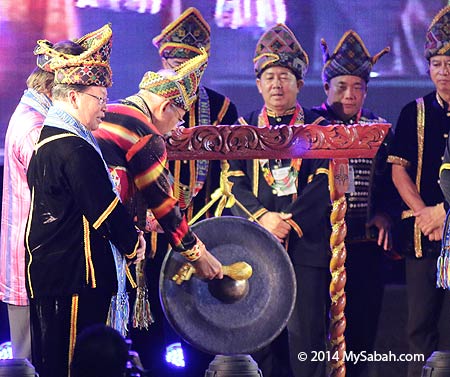
Pic: Beating gong 1 or 7 times is a common way to launch an event by VVIP
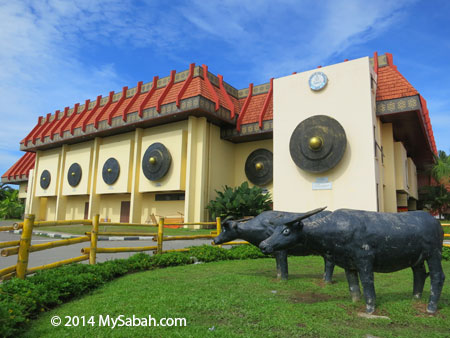
Pic: gong as a symbol of Kadazandusun culture on building of KDCA Penampang
“If you can’t sing, you can beat a gong.” – John H. Alman
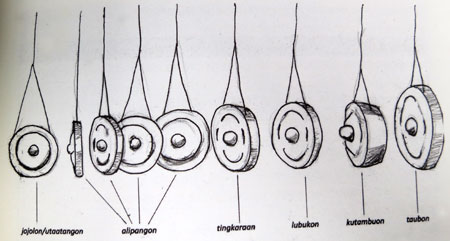
Pic: structure of gong ensemble of Murut Timugon community (Source: Jacquline Pugh-Kitingan)
There are many types of gongs, but in general gong can be divided into three main groups, namely, tawak, chanang, togung. Some gongs have interesting motif on it. Individual gong also has a name which denotes its sound or rhythm it plays. These musical names vary in different tribes.
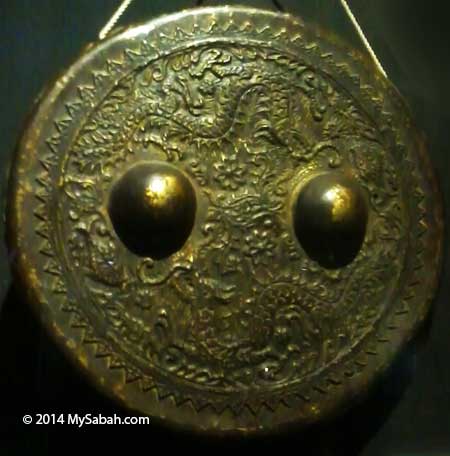
Pic: Chanang Kimanis gong, note it has two bosses
You may play the following video to listen to the sound of gong:
Kampung Sumangkap, the Gong Making Village
In Matunggong of Kudat district, you can see gong making process at gong factory of Kampung Sumangkap (Sumangkap Village). When I entered the village, I saw no “factory” but a typical Sabah village of over 60 wooden houses, with 30 or more gong workshop scattered near to them.
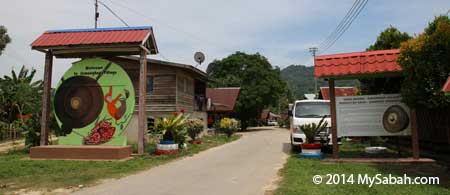
Pic: entrance of Kg. Sumangkap Gong Factory
By the way, visitor is required to pay a small fee at the ticket booth near the entrance. The gong factory is open daily from 8:30am to 5:30pm (including public holiday). The following is the rate of Admission Fee (as of Jul 2014):
Adult (12 years and above): RM5.00 (≈US$1.60)
Children (6 to 12 years old): RM3.00 (≈US$1)
Children (below 6 years old): Free
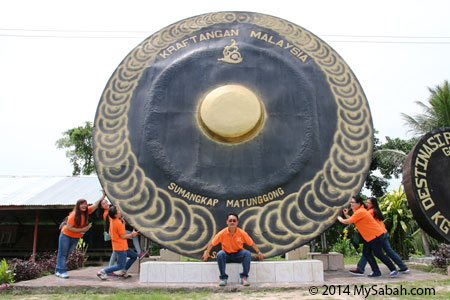
Pic: trying to lift the Biggest Gong in Malaysia (or in the world?)
The highlight of this village is the Biggest Gong in Malaysia. This giant gong is 22 feet tall and weigh 980 Kilograms. Funded by Malaysia Handicraft, it took 5 weeks for 4 local gong craftsmen to make this gong from 20 pieces of 4’x8′ zincs.
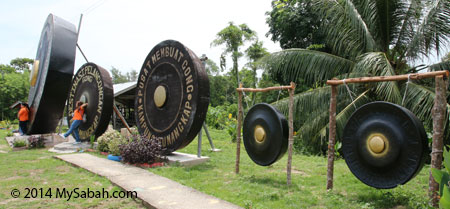

There are many other big gong displayed in the field for tourists to take photos with.
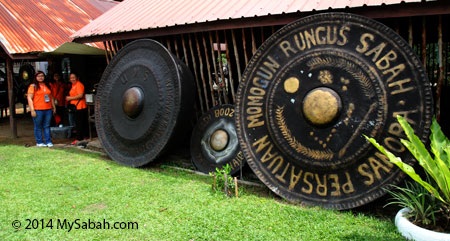
Sumangkap Gong Village was inspired and initiated by a well-known local Gong craftman named Mr. Majabab @ Majabab B. Omlunru in 1968.
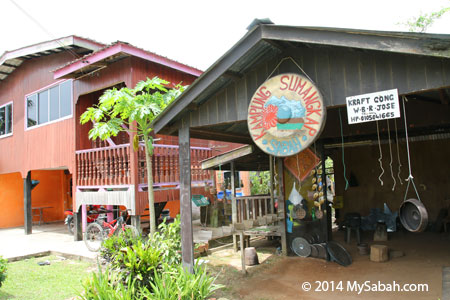
Pic: Gong workshop next to village house
Visitors can walk freely in the village and visit individual gong workshop to see craftsman making gong. Probably I visited on weekend, so the village was quiet and only two families busy making gong.
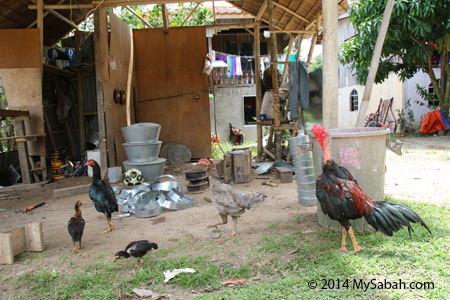
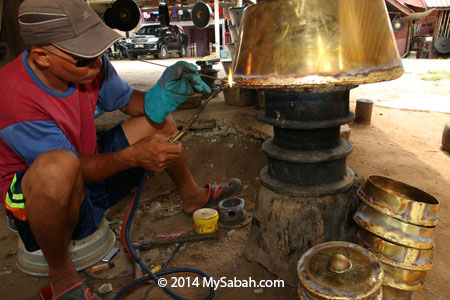
Before the visit, I thought I would see sweating gong-smith pounding iron next to a flaming stove, in a smokey and noisy environment. Instead, the gong makers use gas welder to melt and join pieces of galvanized iron sheets together, and occasionally using hammer to touch-up the outline of gong.
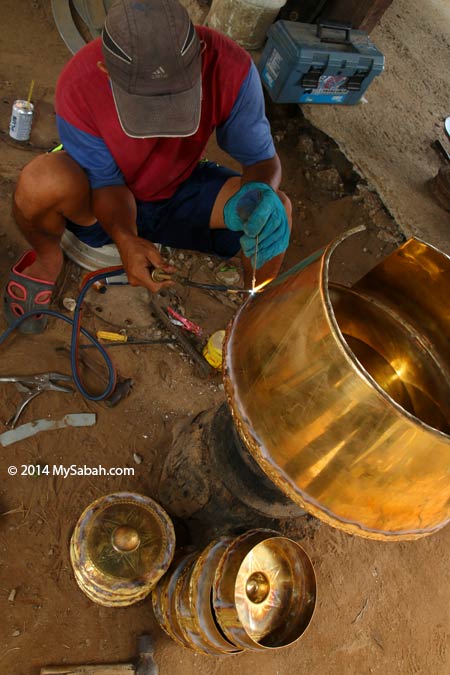
Most villagers are Rungus, the indigenous people of Sabah. Rungus is skillful in all sorts of craftwork and their women are the best weaver and handicraft maker in Sabah. They are very friendly and totally don’t mind I busybody around while they work.
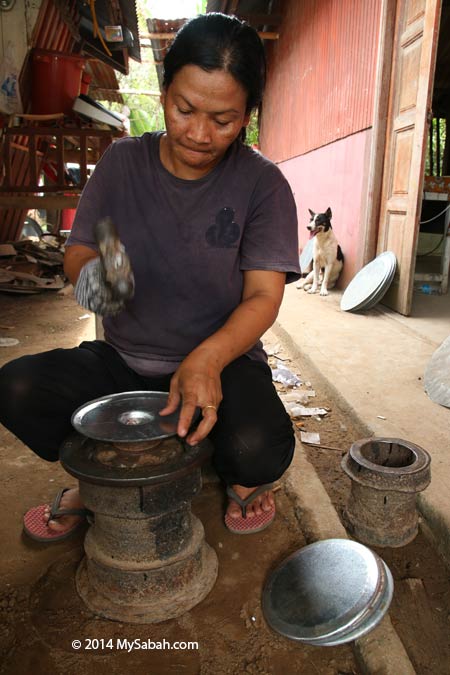
Pic: a woman making the boss and base of the gong
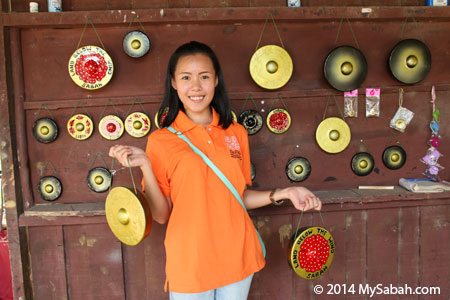
Each gong workshop is a shop by itself. Besides watching gong making and buying gong, variety of smaller souvenirs in gong shape are available for sale on the spot. The smallest item is gong key-chain that costs only a few bucks. You also can bargain with the seller.
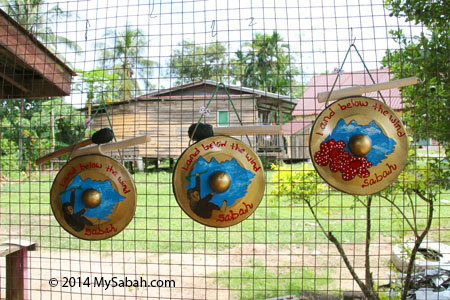
A complete set of gong can cost thousands of dollars. As gong is in good demand, Sabah also imports gong from the Philippines, Indonesia or Brunei. Now this village supplies 80% of gong throughout Malaysia.
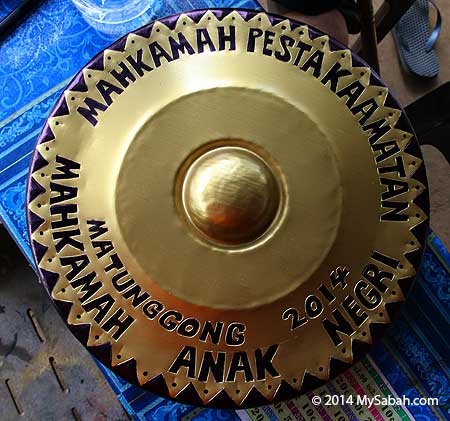
You also can order custom-made gong, in the size, motif / design and wording that you specify. How cool it is to use gong as an ornamental signage for your shop / house.
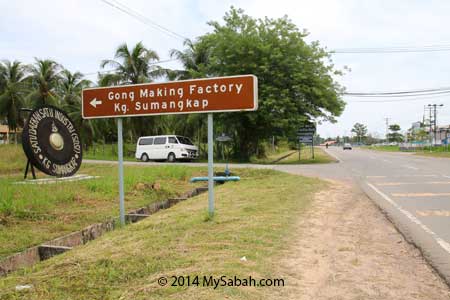
Sumangkap Gong Village is very accessible but very far, it’s about 140 KM north of Kota Kinabalu city (See location map). Just follow the highway to Kudat town, after 2.5 hours of driving you will see a brown signage reads “Gong Making Factory Kg. Sumangkap” and a big gong at your left in Matunggong area (see photo above). Turn to that junction and you will reach Sumangkap in minutes.
Matunggong Gong Festival
To have more fun with gong, you may visit the annual Gong Festival of Kg. Sumangkap.
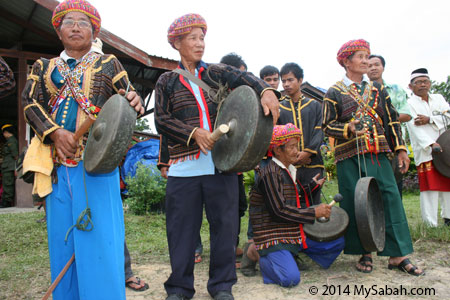
Pic: Rungus people beating gong in Matunggong Gong Festival
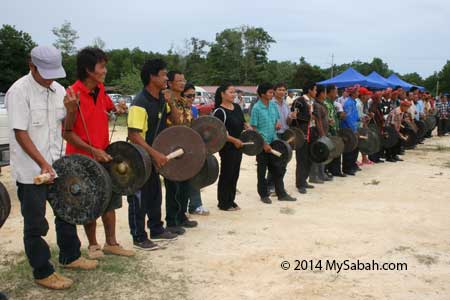
As an opening, hundred of gong will be beaten by villagers and tourists, making it the noisiest festival of Sabah.
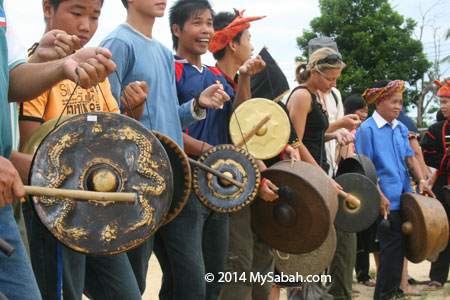
The gong beating is “fire at will” style. Just beat the gong non-stop until you make all the birds within 10 KM radius flee.
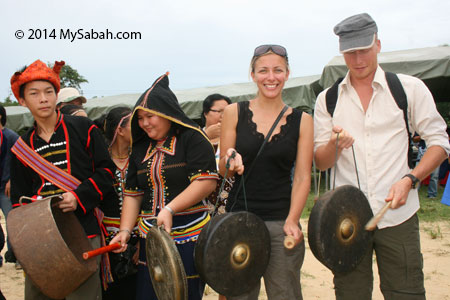
Pic: tourists have fun beating gong
After the launching, there are “Queen of Gong” beauty pageant and cultural performance line up for your enjoyment.
Posts related to Gong
Music of Gong Rock
A few children discovered strange rocks on riverbank when they were swimming at a river in Tambunan. When being hit, the rocks produce gong-like sound.
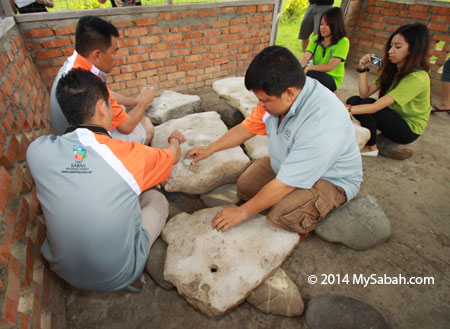
» Read Full Story…
The Cursed Gong Rock
This mysterious rock laying deep in the forest and looks like a gong. Legend says it is from a cursed longhouse. It’ll bring flood when disturbed.
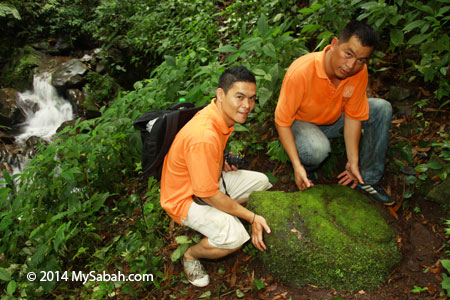
» Read Full Story…
Reference
“If you can’t sing, you can beat a gong”, by John H. Alman, Sabah Society Journal September 1961
Photos taken in Sabah, Malaysia Borneo
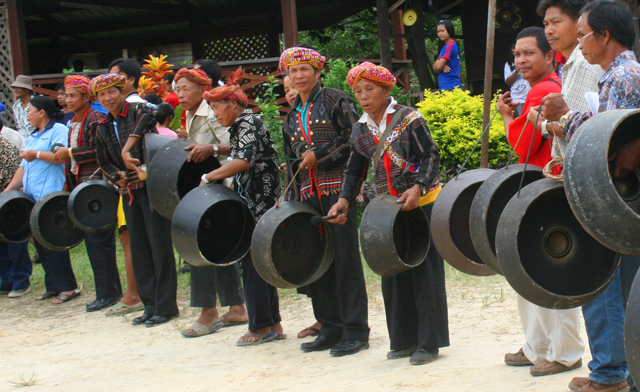



Keep Calm and Beat a Gong lol. Siok.
Now I’ve never seen so many gongs in one place haha. A variety of gongs.
And I don’t even know about that Gong Making Factory. I hope I can visit the place in the near future.
Happy Tuesday, buddy.
http://www.theokayarms.com
Hehe, yea Arms, let’s go there beating some gong, syok. 😀